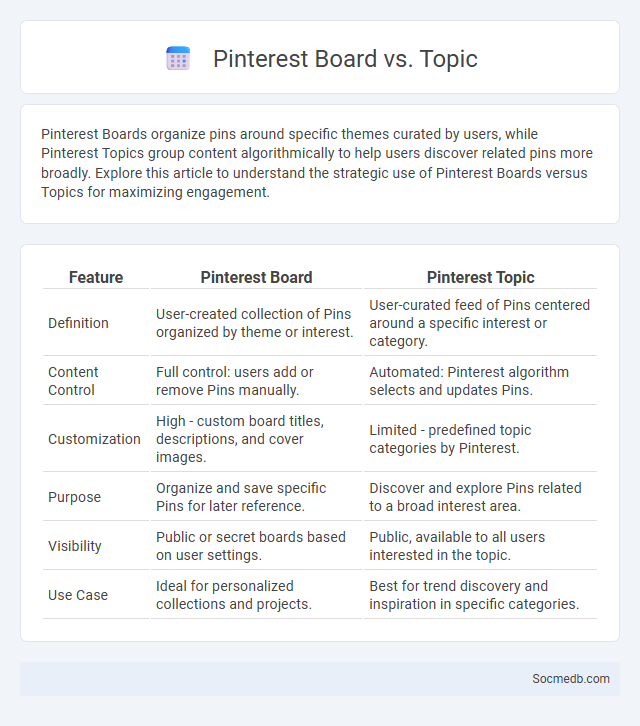
Photo illustration: Pinterest Board vs Topic
Pinterest Boards organize pins around specific themes curated by users, while Pinterest Topics group content algorithmically to help users discover related pins more broadly. Explore this article to understand the strategic use of Pinterest Boards versus Topics for maximizing engagement.
Table of Comparison
| Feature | Pinterest Board | Pinterest Topic |
|---|---|---|
| Definition | User-created collection of Pins organized by theme or interest. | User-curated feed of Pins centered around a specific interest or category. |
| Content Control | Full control: users add or remove Pins manually. | Automated: Pinterest algorithm selects and updates Pins. |
| Customization | High - custom board titles, descriptions, and cover images. | Limited - predefined topic categories by Pinterest. |
| Purpose | Organize and save specific Pins for later reference. | Discover and explore Pins related to a broad interest area. |
| Visibility | Public or secret boards based on user settings. | Public, available to all users interested in the topic. |
| Use Case | Ideal for personalized collections and projects. | Best for trend discovery and inspiration in specific categories. |
Understanding Pinterest Boards: Definition and Purpose
Pinterest boards are curated collections of pins centered around specific themes or interests, helping users organize and visually categorize ideas, inspiration, and products. Serving as digital mood boards, these boards enable you to save and share content related to hobbies, projects, or business marketing strategies. Understanding the structure and purpose of Pinterest boards enhances your ability to discover new trends and connect with niche communities effectively.
What is a Pinterest Topic? Key Differences Explained
A Pinterest topic is a curated collection of pins centered around a specific interest or theme, designed to help users discover relevant content effortlessly. Unlike general boards, Pinterest topics automatically aggregate pins from various sources, enhancing content visibility and engagement through algorithm-driven personalization. This feature distinguishes itself by focusing on niche interests, enabling targeted marketing and refined search capabilities within the platform.
Boards vs. Topics: Understanding the Core Distinctions
Boards serve as organized collections where users curate posts around a central theme, enabling focused content discovery and long-term engagement. Topics, on the other hand, represent broader subject categories that aggregate relevant discussions and posts, facilitating real-time interaction and trend monitoring. Understanding the distinction between Boards as personalized content hubs and Topics as dynamic conversation areas enhances strategic social media management and targeted audience engagement.
How Pinterest Boards Work: Structure and Functionality
Pinterest boards organize your pins around specific themes or interests, allowing you to categorize and display visual content effectively. Each board functions as a virtual bulletin board where you can save, arrange, and share images, links, and ideas relevant to your personal or professional goals. By curating boards strategically, you enhance discovery and engagement, making it easier for your audience to find and interact with your content.
Exploring Pinterest Topics: Categorization and Discovery
Pinterest offers a robust categorization system that organizes content into distinct topics such as home decor, fashion, and travel, enhancing user discovery through visually-driven pins. Its algorithm leverages user behavior and interests to recommend personalized topic feeds, facilitating efficient exploration of relevant ideas and trends. This structured approach to topic categorization boosts engagement by connecting users with curated content that matches their preferences and creative needs.
Board Sections: Organizing Content Within Boards
Board sections enhance content organization by grouping related pins under specific categories within a board, improving user navigation and content discoverability. Properly labeled sections enable users to quickly access niche topics, increasing engagement and saving time during content exploration. This structured approach supports brand storytelling and targeted marketing strategies on platforms like Pinterest.
Benefits of Using Boards vs. Following Topics
Boards enable you to organize content visually, making it easier to revisit and categorize ideas aligned with your interests. Following topics provides real-time updates and a continuous stream of curated information, keeping you informed on trends without manual sorting. Utilizing boards enhances personalized content management, while topics ensure timely discovery of relevant discussions.
Content Discovery: Board vs. Topic Algorithms
Content discovery on social media platforms varies significantly between board algorithms and topic algorithms, with board algorithms curating personalized collections based on user behavior and preferences, enhancing your engagement through tailored content clusters. Topic algorithms analyze trending subjects and keywords to present the most relevant posts across a broad audience, prioritizing timely and popular information. Understanding these differences helps optimize your content strategy for maximum visibility and interaction.
Best Practices: When to Use Boards or Topics
Boards are ideal for organizing content around broad themes or categories, helping users visually navigate their interests with ease. Topics work best for tagging specific discussions or content, enabling targeted searches and fostering community engagement around niche subjects. You can optimize your social media strategy by choosing boards for structured, high-level content curation and topics for dynamic, conversation-driven interaction.
Maximizing Pinterest Engagement: Boards, Topics, and Strategy
Maximizing Pinterest engagement requires curating visually appealing boards with niche-specific topics that resonate with your target audience. Your strategy should include consistent pinning, leveraging trends, and using keywords in board titles and descriptions to improve discoverability. Optimize your profile by analyzing audience insights to tailor content that drives clicks, saves, and follows effectively.
 socmedb.com
socmedb.com